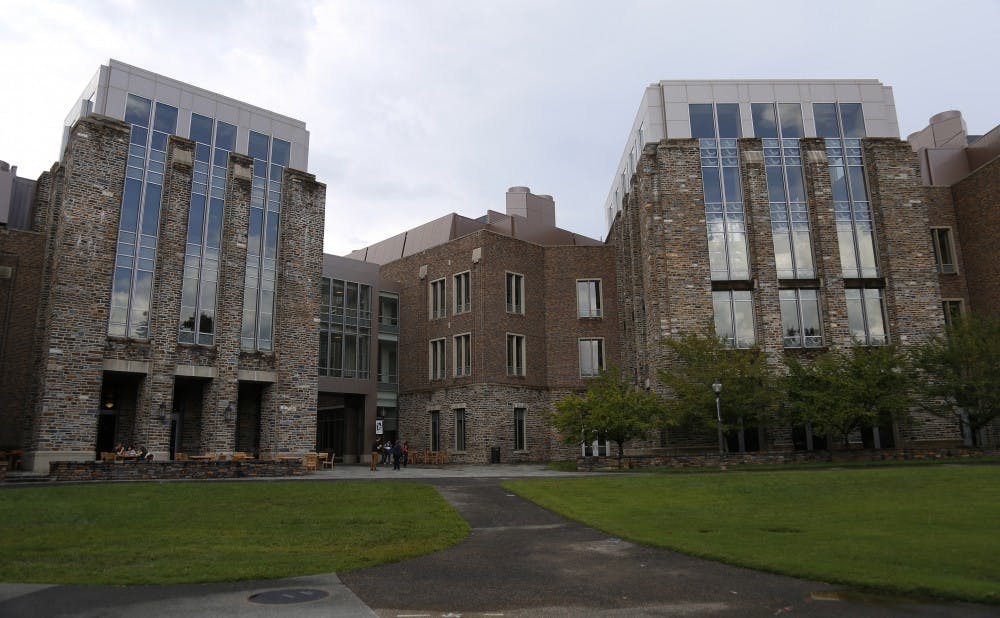Birds may finally be free to fly at Duke.
The University has begun applying patterned films onto windows in CIEMAS in order to reduce bird collisions with transparent glass, and finished applying the material Sept. 15. The move comes after Natalia Ocampo-Peñuela and Scott Winton, fifth- and sixth-year Ph.D. students at the Nicholas School of the Environment, respectively, led a six-person team in investigating the problem of bird deaths on Duke’s campus . Their research found that 72 percent of bird collisions occurred at CIEMAS—birds saw the transparent glass windows, mistook it for open space and eventually collided with the window. During the summer, the University initiated a process to ensure bird safety on campus by applying a patterned film—also called frit—to CIEMAS’ windows, so that birds know to avoid the building.
“We had a ton of data on our side as well as student support with students saying it was a problem, and they wanted the University to fix it,” Winton said. “At that point, it's really hard for the University to justify doing nothing.”
The Bird Window Collision Project has been receiving complaints from students about dead birds on campus for years, Ocampo-Peñuela said, but project researchers did not begin a formal study of the problem using a standardized approach until the Spring 2014 semester. The project has continued to collect data for three semesters and is entering its fourth this Fall.
Ocampo-Peñuela explained that she and Winton met with Duke Facilities Management last Spring to advocate for improvements. In addition to attributing the majority of the problem to CIEMAS, Ocampo-Peñuela also referenced a study by the Ecological Research as Education Network during the meeting suggesting that—out of 45 different universities across the country—Duke ranked the worst in terms of the number of on-campus collisions.
As a result of those meetings, Duke decided to retrofit CIEMAS’ upper-level windows —the ones that caused the most bird deaths— by applying a dotted film to the glass and peeling it off so that the dots remain on the windows. Birds can see these dots and avoid the windows as a result, Winton said.
Michael Schoenfeld, vice president for public affairs and government relations, confirmed via email that the retrofitting process is still ongoing and should be complete by the end of September.
The alternative to retrofitting current buildings with film is to build a ceramic frit onto the windows during the initial construction of the building itself. Other buildings on campus, such as Penn Pavilion and Environment Hall, were fritted in this way, and as a result are significantly more bird-safe than CIEMAS was.
The frit does not need to be plain dots in order to ensure bird safety, Ocampo-Peñuela noted. As long as parts of the frit pattern are condensed to within three inches of each other—necessary to make the frit clearly visible to birds—any aesthetic design could work. Environment Hall’s frit design was patterned off of a window in Duke Chapel.
Moving forward, Duke’s chapter of the Bird Window Collision Project intends to explore a potential connection between buildings certified by the US Green Building Council as demonstrating Leadership in Energy and Environmental Design and bird death, Ocampo-Peñuela said.
While the connection has not been proved definitively, Ocampo-Peñuela and Winton suspect that LEED certifications—which emphasize energy efficiency and natural light—contribute to the rise of glass windows that are so dangerous to birds.
Additionally, LEED certification only has one credit—out of the many needed to get certified— related to bird safety. That requirement, which requires inspection as well, seems pointless and onerous to many people, Winton said, adding that the project is pushing for LEED to make bird safety a bigger part of its certification rubrics.
It is also possible that fritted windows could help buildings achieve energy efficiency, Winton said. Fritted windows help to both bring in natural light and reduce “solar heat gain,” which is a burden on energy efficiency.
Schoenfeld wrote in an email Monday that Duke is “incorporating measures to avoid bird collisions into newly designed and renovated buildings.”
Ocampo-Peñuela’s goal for the upcoming Fall survey is to see whether or not applying the film to CIEMAS has actually alleviated the problem.
She hopes that if the results are promising Duke can be further pushed to take action on other buildings—such as French Family Science Center or the Law School—as well as provide motivation for similar advocacy groups on other campuses.
“They’ve given us a great opportunity, because migration is going to start soon and we can see if it works,” she said.
Update: This story was updated Sept. 15 to include the completion date of the project and to reflect that formal research began in Spring 2014, not Spring 2013, and add that Ocampo-Peñuela and Winton were part of a six-person team. The Chronicle regrets the errors.
Get The Chronicle straight to your inbox
Signup for our weekly newsletter. Cancel at any time.

